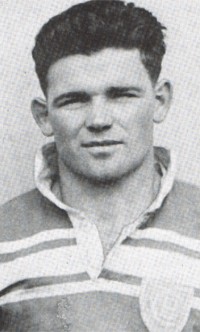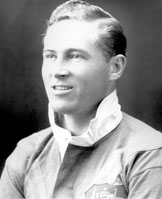Related Research Articles

Drummoyne is a suburb in the Inner West of Sydney, in the state of New South Wales, Australia. Drummoyne is six kilometres west of the Sydney central business district and is the administrative centre for the local government area of the City of Canada Bay.

Ronald William Willey (1929−2004) was an Australian rugby league footballer and coach. He was a representative for the Australian national side. Post-playing, Willey had a long and successful first grade and State representative coaching career.

Scott Hill is an Australian former professional rugby league footballer who played in the 1990s and 2000s. He was previously with the Harlequins RL club in the Super League. His usual position is at five-eighth. Hill previously played in Australia for the Melbourne Storm, Hunter Mariners and the Canterbury-Bankstown Bulldogs. Hill is a former New South Wales and Australian representative player.
The 1909 New South Wales Rugby Football League premiership was the second season of Sydney's top-level rugby league football competition, Australia's first. Eight teams contested during the season for the premiership and the Royal Agricultural Society Challenge Shield; seven teams from Sydney and one team from Newcastle, New South Wales.
Robert Henderson Graves was a pioneer Australian rugby league and rugby union player and one of his country's first dual-code internationals. He was a versatile forward for the Australia national team. He played in 6 Tests between 1908 and 1909, as captain on 1 occasion. In 1907 he played for New South Wales in the first rugby match run by the newly created 'New South Wales Rugby Football League' which had just split away from the established New South Wales Rugby Football Union.

Jim Craig (1895–1959) was an Australian rugby league footballer and coach. He was a versatile back for the Australian national team. He played in seven tests between 1921 and 1928 as captain on three occasions and has since been named amongst the nation's finest footballers of the 20th century. Craig was a player of unparalleled versatility. It is known that he represented in Tests at fullback, centre, halfback and hooker with some of his club and tour football played at winger, five-eighth and lock forward. Whiticker's reference reports that the great Dally Messenger regarded Craig as the greatest player Messenger ever saw.
The 1964 NSWRFL season was the fifty-seventh season of Sydney's professional rugby league football competition, the New South Wales Rugby Football League Premiership, Australia's first. Ten clubs from across the city competed for the J. J. Giltinan Shield and the WD & HO Wills Cup during the season, which culminated in a grand final between St. George and Balmain.
The 1988 NSWRL season was the 81st season of professional rugby league football in Australia, and saw the first expansion of the New South Wales Rugby League Premiership outside the borders of New South Wales, and another expansion outside of Sydney, with the addition of three new teams: the Brisbane Broncos, Newcastle Knights and Gold Coast-Tweed Giants. The largest NSWRL premiership yet, sixteen clubs competed during the 1988 season, with the J J Giltinan Shield for minor premiers going to Cronulla-Sutherland Sharks. The finals culminated in a grand final for the Winfield Cup between the Canterbury-Bankstown Bulldogs and Balmain Tigers. This season NSWRL teams also competed for the 1988 Panasonic Cup.

Joe Jorgenson was an Australian rugby league footballer of the 1940s and '50s. He was a three-quarter for the Australian national team who played in three Tests in 1946, two as captain. Jorgensen also represented New South Wales and played for Sydney's Balmain club, winning the 1944, 1946 and 1947 Premierships with them.
The 1966 New South Wales Rugby Football League premiership was the 59th season of the rugby league competition based in Sydney. Ten clubs from across the city competed for the J.J. Giltinan Shield and the WD & HO Wills Cup during the season, which culminated in a replay of the 1964 grand final between St. George and Balmain.

Drummoyne Oval is a multi-use sports ground in the Sydney inner-west suburb of Drummoyne, New South Wales. The ground has been used for international women's cricket matches, domestic men's cricket matches and first grade rugby league as well as local Australian rules football and Rugby Union games.
Phil Sigsworth, is an Australian former professional rugby league footballer. He played primarily in the fullback position. Sigsworth attended Newtown Boys' Junior High School where he played Rugby Union for the school. His junior Rugby League playing days were with the Erskineville Juniors club and then the infamous Newtown Hawks from where he was graded into the district club, Newtown District Rugby League Football Club.
Graham Lyons is an Indigenous Australian, and a former professional rugby league footballer who played for South Sydney, Penrith and Balmain in the New South Wales Rugby League (NSWRL) competition. Lyons primarily played on the wing but spent the majority of the 1989 season in the centres. He is the cousin of fellow rugby league player Cliff Lyons.
David Brooks is an Australian former professional rugby league footballer who played in the 1980s and 1990s. A one-club man, Brooks played his first-grade career primarily with the Balmain Tigers in the New South Wales Rugby League premiership, with a couple of short stints in England in the off-season with Hull FC and later with Chorley Borough. Brooks primarily played in the second-row.

Fred de Belin was an Australian professional rugby league footballer who played in the 1940s and an RAAF Flying Officer who saw active service over Germany during WWII. An Australian international and New South Wales interstate representative forward, he played club football in Sydney for Balmain, winning the 1946 NSWRFL Premiership with them and later being appointed their captain.
Geoff Starling is an Australian former professional rugby league footballer who played in the 1970s. An Australia international and New South Wales interstate representative three-quarter back, he played club football in the NSWRFL Premiership for Sydney's Balmain Tigers club.
Reginald Augustine 'Whip' Latta (1897–1970) was an Australian professional rugby league footballer who played in the 1910s and 1920s who also became a coach. An Australia national and New South Wales state representative forward, he played his club football in Sydney for the Balmain club, with whom he won five premierships. Latta also coached the team.
Ian Victor Tutty is an Australian former representative rower. He was a three-time national champion sculler and an Olympian who competed in the men's double sculls event at the 1960 Summer Olympics. He was a 1962 Commonwealth Games bronze medallist.
Laurie Moraschi (;) (1942-2018) was an Australian rugby league footballer who played in the 1960s and 1970s. He played in the NSWRFL premiership for North Sydney and Balmain.
Peter Jones is an Australian former rugby league footballer who played in the 1950s and 1960s. He played for Balmain in the New South Wales Rugby League (NSWRL) competition.
References
- ↑ James Hooper (13 April 2008). "All should hail King Tutty". The Daily Telegraph (Sydney). Retrieved 1 June 2008.
- ↑ Dabscheck, Braham (2009). "Righting a wrong: Dennis Tutty and his struggle against the New South Wales Rugby League". Australian and New Zealand Sports Law Journal: 145–55. Retrieved 19 February 2014.
- ↑ Guerin, Andrew. "History of Australian Rowing". Archived from the original on 24 September 2018. Retrieved 19 February 2014.
- ↑ "Clayton Cup". Country Rugby League Annual Report (1994, 1995). Sydney: N.S.W. Country Rugby League.